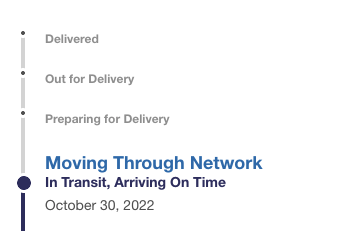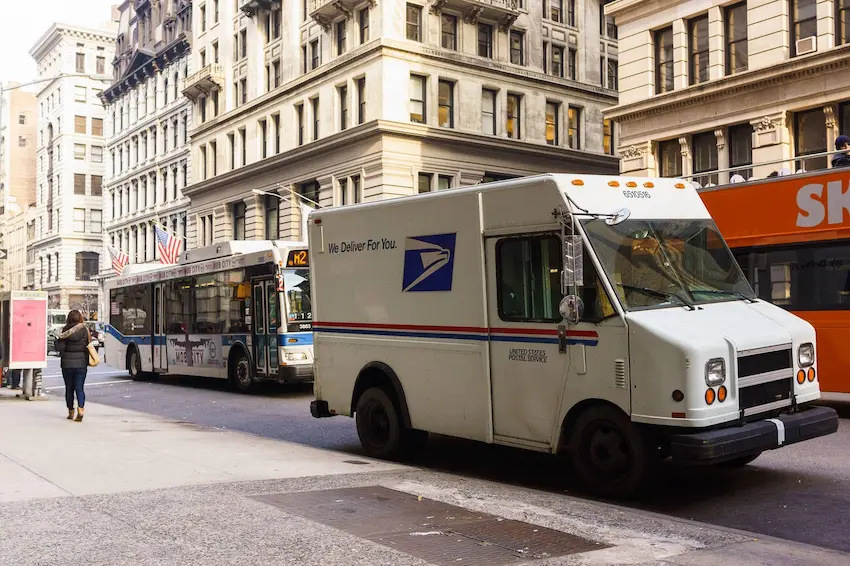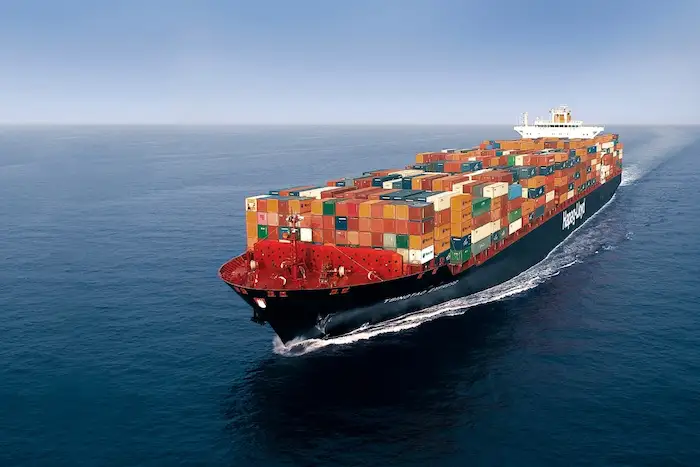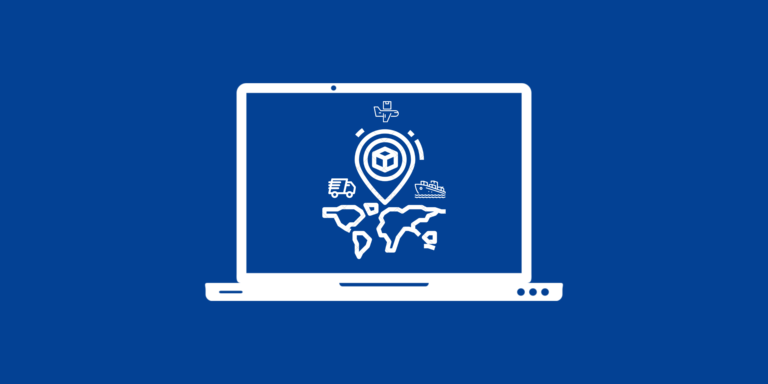Understanding “Moving Through Network” in USPS Tracking: A Comprehensive Guide
Online shopping is incredibly convenient, but after you confirm your order, your purchase starts its journey through the package delivery process. Tracking updates become crucial for peace of mind. However, have you ever wondered about the term “Moving Through Network”?
This status might leave you wondering where your package is, but fear not! This guide sheds light on its meaning, equipping you to track your USPS deliveries with clarity and confidence. Join us on a voyage through the intricate network of the United States Postal Service, demystifying every scan and update along the way.
What Does “Moving Through Network” Mean?

Have you ever looked at your USPS tracking details and seen the enigmatic “Moving Through Network”? Though it might seem a bit puzzling, don’t worry! We will help you understand this status, so you can confidently track your USPS deliveries.
Breaking Down the Status
If your package is navigating the USPS network with the status “Moving Through Network” it means it’s in transit. It’s moving through distribution hubs and sorting centers, steadily getting closer to your location. While it hasn’t reached your local post office yet, rest assured, it’s on its way.
The Significance for Your Package
This status shows that your package is moving and not collecting dust in a back corner. It has been processed and scanned, moving past the first point of entry and farther into the USPS network. It verifies that your package is in motion and is getting closer to your door with each scan and sort, even though it cannot provide the precise location.
The Journey of a Package Within the USPS Network:
Curious about the journey your package takes from your local post office to your doorstep? This guide serves as a map, outlining the typical path from drop-off to delivery, covering sorting and shipping along the way.
From Shipping to Delivery
The journey of your package starts at the post office in your community, where staff scan it and attach a tracking label. From there, it zips through the e sorting center, whizzing along conveyor belts and being sorted by postal efficiency wizards and robots. It then boards a truck headed for a Network Distribution Center, a busy intersection where packages from different sorting centers congregate, depending on where it is ultimately going. Scanners read destinations like a well-oiled machine, and packages are sorted quickly onto departing trucks. While some find their last ride to their local post offices, others set out on journeys to further sorting centers. After a crazy journey, it finally reaches your neighborhood post office, where it is prepared to be delivered directly to your door.
Key USPS Facilities and Checkpoints
After following the usual route of your package, let’s take a closer look at the main amenities that ensure a seamless travel experience:
Sorting Centers: These advanced warehouses use optical scanners and automated equipment to quickly move packages along conveyor belts. The goal is to accurately read addresses and guide them in the right directions, ensuring your package arrives on time.
Network Distribution Centers (NDCs): These are like big logistical hubs where trucks from different sorting centers drop off loaded packages. Effective loading and sorting onto departing trucks keep the network moving smoothly, for your package.
Processing and Distribution Centers (PDCs): These large facilities manage a high volume of mail and packages, often with short-term storage for peak seasons. Think of them as massive warehouses constantly supplying packages to keep the network flowing.
Local Post Offices: These friendly neighborhood hubs handle the last part of your package’s journey. Postal employees sort and prepare packages for local delivery, ensuring they reach their intended recipients quickly and safely. Your neighbourhood post office is the final stop before your package reaches its destination.
Decoding Delivery Timelines and Delays:
When you look at your USPS tracking information, the cryptic phrase “Moving Through Network” appears, causing a twinge of anxiety and excitement. Although it shows that your package is on its way, not having a firm arrival date can make you wonder when you’ll actually be able to hold it in your hands. Well… you will be able to confidently navigate the “Moving Through Network” status by understanding the complexities of delivery timelines and potential delays.
Understanding Expected Delivery Timelines
The “Moving Through Network” status may appear ambiguous, but it’s not! Though estimated delivery dates serve as useful benchmarks, the package’s journey may occasionally take interesting detours. USPS offers a range of mail services to meet diverse needs.
Priority Mail Express is the fastest, ensuring delivery within 1-2 days anywhere in the US, but it comes with a premium price. Priority Mail, a slightly slower option, delivers in 2-3 business days, handling heavier packages at a more budget-friendly rate. First-Class Mail is perfect for lightweight items like letters and postcards, with delivery in 2-5 business days. Businesses can opt for USPS Marketing Mail, an economical choice for flyers and catalogs, though with a slower delivery time of 3-10 business days. Package Services cover a variety of options, from the slower and affordable USPS Retail Ground to Priority Mail Cubic, ideal for oddly shaped boxes, offering flexibility to match different needs and budgets.
Remember that the estimated delivery date on the map represents only a flag and not the actual destination. So, take a deep breath and focus on the positive: every “Moving Through Network” update signifies progress, each scan and sort bringing your package closer to your eager hands.
Common Causes for Delays
There are hiccups in even the most efficient networks. The following are some possible explanations for why “Moving Through Network” may be taking so long for your package:
- Weather Events: Hurricanes, floods, and blizzards can cause temporary delays in transportation until the situation clears up.
- Mechanical Problems: Sorting machinery malfunctions or vehicle breakdowns can momentarily stop package movement.
- Customs Inspections: When international packages are subject to customs inspections, their travel time is extended.
- Unexpected Network Volume: Unexpected increases in the number of packages received, particularly during busy times of the year, can cause backlogs and delay processing.
Although delays can be annoying, patience and understanding are your allies while your package navigates these occasional roadblocks. Thankfully, USPS tracking tools offer updates, and contacting customer service can provide further insight into your package’s specific situation.
Don’t get stuck in a tracking loop of endless refreshes and unanswered calls. Break free from the confusion and chaos with GoComet. Enjoy real-time freight location, multi-carrier tracking, and proactive delay alerts, all in one dashboard. Say goodbye to uncertainty and take control of your package journey.
Troubleshooting and Managing Delays
After several days of “Moving Through Network” updates, there is an eerie quiet. Keep your frustration in check! This section gives you the tools to confront delays head-on and successfully negotiate the complex path leading to the delivery of your package.
Steps to Take When a Package is Stuck
While being proactive can lessen the pain of a delayed package, patience is still essential. What you can do is as follows:
Give it time: Before making hasty decisions, give yourself a few extra days after the anticipated delivery date. There are occasionally brief lags in the network.
GoComet’s real- time tracking: Spot where and why your package is stuck with GoTrack by GoComet. Gain real-time insights and proactive alerts for more control over your deliveries.
Use the USPS tracking resources: Beyond just “Moving Through Network,” the website provides comprehensive information, such as the location of the most recent scan and possible causes of delay.
Speak with USPS customer service at: Kindly agents can look into the particular circumstances surrounding your package and provide useful solutions.
Utilizing USPS Tracking Tools and Resources
The USPS website is a goldmine of tools and resources for managing your shipments; it’s more than just a static tracking board. Here are a few very useful allies:
- Track & Confirm: This tool lets you set up email or text alerts for important milestones and gives you comprehensive scan updates and estimated delivery dates.
- Informed Delivery: Check out the pictures and projected delivery dates of incoming mail and packages so you can schedule your day appropriately.
- Retain Mail: Taking a holiday? This service makes sure that during your absence, your package doesn’t sit around the post office.
- Assistance & Encouragement: An extensive collection of frequently asked questions, troubleshooting guides, and customer support contact details.
You can take charge of your USPS experience and turn “Moving Through Network” from a mysterious phrase to a helpful step on your package’s path to your door by becoming familiar with these tools.
Insights from USPS Tracking Data:
There’s more to the mysterious world of USPS tracking than just scan locations and estimated delivery dates. Fascinating insights into the complex dance of package movement throughout the United States are concealed within this data. Let’s decipher the code and investigate the tacit patterns and methods present throughout the extensive USPS network.
Trends in Package Movement
Interesting patterns in package behavior are revealed by USPS data. As you may have known:
- Geographical factors come into play: because of the greater infrastructure and population density on the East Coast, packages there typically arrive faster than those on the West Coast.
- Day of the week matters: Because of the weekend traffic spike, Fridays typically experience slower processing.
- Shipping services are important: Generally speaking, Priority Mail moves more quickly than First-Class or Media Mail.
These patterns suggest that the network is dynamic and always changing to maximize flow and delivery times. You can manage your delivery expectations and select the most cost-effective shipping option by being aware of these trends.
How USPS Handles High Volume and Peak Seasons
Package activity on the USPS network can become chaotic during the holiday rush. But worry not—the USPS has a number of plans in place to deal with the influx:
- Temporary facilities: To handle the increased volume, pop-up distribution hubs and sorting centers appear.
- Extended hours: Hardworking employees work overtime to maintain the network’s functionality.
- Predictive analytics: By analyzing USPS data, one can foresee peak times and allocate resources appropriately.
- Partnerships: When things get busy, working together with logistics firms gives you more capacity and support.
These precautions guarantee that your package makes it through the hectic holiday season, though delivery times may be a little longer than expected. Understanding and patience are essential during these times, as the USPS is working hard to deliver your holiday cheer on time.
Looking to the Future: Innovations in USPS Tracking:
Although “Moving Through Network” may be the key to tracking the location of your USPS package right now, more interactive and transparent tracking options are on the horizon. Settle in, adventuresome seekers of parcels, for we are about to explore the fascinating realm of cutting-edge technologies that have the potential to completely transform customer experience and revolutionize USPS tracking.
Technological Advancements in Package Tracking
The USPS is constantly improving. The following innovative developments are changing the tracking scene:
Real-time GPS tracking: Visualize looking through a crystal ball to see the precise location of your package, mile by mile. GPS-enabled tracking chips, which would provide unmatched insight into the path of your package, may soon become a reality.
Tools like GoTrack by GoComet can help you track your package. Its real-time tracking features give you comprehensive information about the whereabouts of your delivery. GoComet allows you to choose clarity over confusion.
Analytics that predict: AI is no longer limited to science fiction films. The USPS can anticipate possible delays, proactively reroute packages, and provide even more precise delivery estimates by analyzing enormous amounts of data.
Improved alerts: Don’t bother continuously refreshing the tracking page. Imagine getting individualized text or email alerts that provide you with precise information about each scan, sort, and estimated arrival time.
With these developments, “Moving Through Network” could become more than just a mysterious phrase—rather, it could become a comprehensive schedule that builds confidence and eases your mind as your package makes its way to you.
The Impact on Customer Experience
Future USPS tracking promises to provide customers with a more flexible and informed experience. You’ll be able to plan your day more effectively with the help of real-time updates and predictive insights that offer more precise estimates. You won’t feel anxious waiting for your package if you receive regular notifications and alerts. Furthermore, functions like holding choices and rerouting requests will give you more control over your deliveries and adjust to your changing requirements. With these technological advancements in tracking, customers will have more information and flexibility, and the “Moving Through Network” status will no longer be an ambiguous placeholder but rather an obvious step in your package’s journey.
Conclusion:
To put it briefly, this blog aims to provide guidance through the complexities of USPS tracking by interpreting the “Moving Through Network” status. Our goal has been to demystify package tracking by providing a clear understanding of every step of the package’s journey, from local post offices to distribution hubs.
Encouraging users to take full advantage of USPS tracking tools, the guide examines delivery timelines and potential delays and offers helpful insights and steps to navigate setbacks. Tracking data reveals package movement patterns that are influenced by shipping services and geographic factors, allowing users to establish reasonable delivery expectations.
We have explored future technological developments in the pipeline and more transparent and interactive tracking experiences. Enhancing customer confidence and comprehension is the aim, with the “Moving Through Network” status being a simple and educational aspect of the package’s journey.






